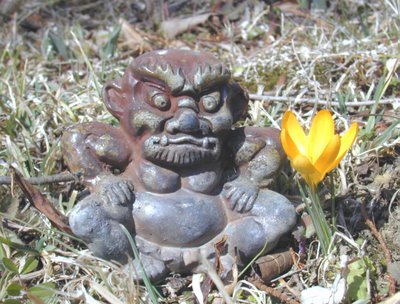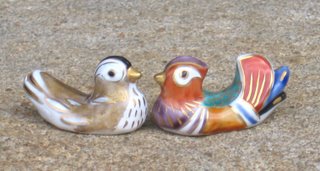| 天の邪鬼 春の日差しに 悪さなし  you can't do harm in the spring sunshine - pretty monsterlin |
Look at more of these monsterlins, called
Ama no Jaku (Amanjaku)
The Japanese story is about our local monsterlin Amanjaku in Ohaga. My friend, the potter Takagaki Mondo 高垣門土, makes these little figures from Bizen Pottery.
:::::::::::::::::::::::::::::::::::::::::::::::::::::::::::::::::::::::::::::::::::::::::::::::::::::
天邪鬼 Heavenly Evil Spirit
. アマンジャク( Jizai-Ten 自在天. Daijizaiten 大自在天) .
Amanojaku is a small demon-like creature who can provoke a person’s deepest and darkest desires, instigating him to do evil deeds.
In the fairytale “Urikohime” 瓜子姫, a girl borne from a gourd was raised by an elderly couple, sheltering her from evil. One day she let Amanojaku inside the house and he killed her, using her skin to impersonate her.

アマノサグ Amanosagu from Aomori
tells the story of Urihime 瓜姫子 from 五戸町 Gonohe Town.
. . . The Amanojaku impersonating the Girl was to be wed. At the Wedding Party the "Girl" ate all the food and was thrown out of the house as a bakayome 馬鹿嫁 useless, dumb bride.
. Legends about Plants 植物と伝説 shokubutsu to densetsu .
.................................................................................

The amanojaku is commonly held to be derived from
Amanosagume (天探女), a wicked deity in Shintō myth, which shares the amanojaku's contrary nature and ability to see into a person's heart, "a very perverted demon".
The creature has also entered Buddhist thought, perhaps via syncretism with the yasha, where it is considered an opponent of Buddhist teachings. It is commonly depicted as being trampled on and subdued into righteousness by Bishamonten or one of the other Shitennō.
In this context it is also called a jaki (邪鬼).
© More in the WIKIPEDIA !
.................................................................................
jakibarai 邪気払い to purify the place or person from evil influence
.................................................................................

Amanojaku at temple Gansenji, Kyoto
岩船寺の三重の塔を支える天邪鬼

amanojaku no mayoke no o-mamori 天邪鬼の魔除のお守り
amulet with Amanojaku
Temple Gansenji 岩船寺
京都府木津川市加茂町岩船上ノ門43
. Amulets and Talismans from Japan .
:::::::::::::::::::::::::::::::::::::::::::::::::::::::::::::::::::::::::::::::::::::::::::::::::::::::::::::::::::::::::::
. Legends about Amanojaku 天邪鬼 .
:::::::::::::::::::::::::::::::::::::::::::::::::::::::::::::::::::::::::::::::::::::::::::::::::::::
[ . BACK to WORLDKIGO . TOP . ]
[ . BACK to DARUMA MUSEUM TOP . ]
:::::::::::::::::::::::::::::::::::::::::::::::::::::::::::::::::::::::::::::::::::::::::::::::::::::








6 comments:
oh gabi
he is a delight his fuzzy eyebrows remind me of the emporers eyebrows he is nice to look at
aloha
shanna
::::::::::::::::::::::::::::::::::::::::::::::::::::::::::::::::::::::
monsterlin, 天邪鬼の像.
初めて見ました。
岡山県にはどこにでもありますか?
I like him because I am monsterlin
too.
sakuo.
Legends from Okayama
岡山の民話と伝説
.
A legend from Nara 奈良県 天理市 Tenri
amanojaku アマンジャク Amanojaku
When 釈迦 Shakyamuni Buddha was practising in the Himalayan Mountains, the deity Taishaku-Ten appeared and received his teaching. Next came Shomen Kongo and his Child-attendants (dooji 童子 Doji), altogether seven in red, green and blue colors.
On many scrolls of this event, beside the three monkeys, there is also an Amanjaku (自在天 Jizai-Ten).
.
More about Shomen Kongo 青面金剛
.
Jaki 邪鬼の伝説 "Evil Spirit" Legends
and Amanojaku 天邪鬼
.
https://kappapedia.blogspot.jp/2017/03/jaki-evil-spirit.html
.
Kobayashi Issa
天の邪鬼踏れながらもさくら哉
ama no jaku fumare nagara mo sakura kana
trampled demons
supporting Buddha's way...
cherry blossoms
The phrase ama no jaku today can mean a stubborn or contrarian person, but Issa is using its literal rather than metaphorical meaning. “Heaven’s Demons” in Buddhist temples are demons that the Four Heavenly Kings stand upon and trample. Though they once were evil, now they support Buddhism. Issa suggests (with a smile) that the people walking on the fallen blossoms are Heavenly Kings, while the blossoms are former demons who now, through their sacrifice of self, pave the way to enlightenment.
David Lanoue
.
Post a Comment